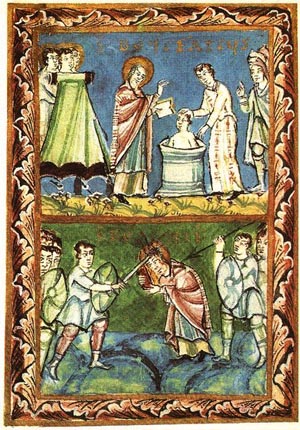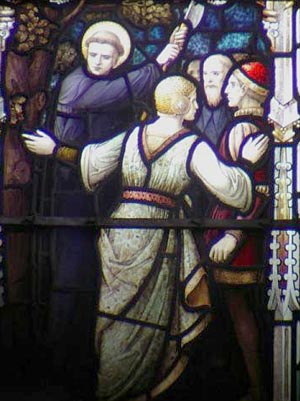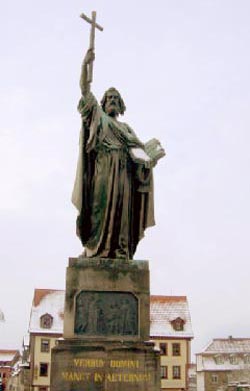 |
The Saint of the Day
St. Boniface – June 5
Prof. Plinio Corrêa de Oliveira
Biographical selection:

In the first picture, St. Boniface baptizes the pagans. Below it, his martyrdom in 754
Sacramentary of Fulda, 11th century |
St. Boniface lived from around 680 to 754. He was born Winfred in the Kingdom of Wessex (now Devon), England. At age 7 he entered the monastery of Adescancastre on the site of present day Exeter. Seven years later he went to the Abbey of Nhutscelle. Here, under the direction of the holy Abbot Winbert, his fame for knowledge and preaching grew.
He set aside, however, prospects of the highest dignities in his own country, because he felt the vocation to convert the pagan Anglo-Saxons in Germany. By the order of Pope Gregory II he dedicated himself to their conversion. He helped Charles Martel in the reform of the Church in France and convened councils to combat simony.
In 719 the monk Winfred took this oath to Pope Gregory II in Rome, when he was made Bishop and given the name of Boniface:
“In the name of the Lord Our God and Savior Jesus Christ. In the sixth year of the reign of Emperor Leo IV and of his son Constantine, I, Boniface, Bishop by the grace of God, promise to thee, Blessed Peter, Prince of the Apostles, and to thy Vicar, the blessed Pope Gregory and his successors, by the indivisible Trinity, Father, Son and Holy Ghost, and by Thy Sacred Body here present, that I will conserve the purity of the holy Catholic Faith, and I will remain steadfast in the unity of this belief, in which indubitably lies the salvation of all Christians. I will never attack the unity of the Catholic Church, no matter who may seek to persuade me, but will maintain a complete fidelity to it, and a sincere commitment to thee and the interests of thy Church.

Pope Gregory II blesses Boniface and sends him to Germany to convert the pagans |
“To thee and thy successors the Lord gave the power to bind and unbind. I promise that I will never have communion with bishops who go astray from the ancient practices established by the Holy Fathers, and that, if I can, I will prevent their actions. If I cannot, I will denounce them to the Pope my Lord. If in any way, God forbid, I should act in opposition to this oath, let me assume the guilt before the judgment of God, receiving the chastisements of Ananias and Saphira, who lied to thee.
“I Boniface, humble Bishop, sign by my own hand the formula of this oath and place it over the body of Blessed Peter. As prescribed, I make this oath before God, who is Judge and Witness. I promise to fulfill it well.”
Pope Gregory II wrote this letter to present St. Boniface in his commission to evangelize Germany and reorganize the Church there:
“If anyone, God forbid, either oppose the work of Bishop Boniface, or thwart his ministry or that of his successors in the apostolate, by the Divine Judge, let him be anathema and subject to eternal condemnation.”
St. Boniface suffered martyrdom in Frisia in 754. His body rests in the cathedral crypt in Fulda, where he is venerated by all Catholic Germany. He is the patron saint of Germany and the Netherlands.
Comments of Prof. Plinio:
For you to have an idea of the role of this saint in the foundation of the Middle Ages, perhaps it is worthwhile to insert the data of this selection into the larger panorama of the times.

In 723 St. Boniface felled the oak dedicated to Thor and the pagans converted |
First, St. Boniface was a monk in an epoch when the monastic life was the most dynamic force of the Church. This energy came from the great monasteries of monks who lived a recollected life. The characteristic note of the Benedictine monasteries, unlike today, was to live away from the cities, in places of solitude. Given their prestige, often entire villages or even cities would grow up around those isolated convents.
Therefore, St. Boniface was an active participant in the most important ecclesiastical movement of his time, which brought the Middle Ages to its apogee.
Second, St. Boniface was a missionary. One of the great works of the
Middle Ages was the evangelization of the barbarian peoples. At his time, most of Europe beyond the Rhine and Danube Rivers was barbarian, as barbarian as the Indians who still live today in the South American forests. The work of conversion and civilization of those peoples was enormous and had great value. One can measure this value considering the magnificent fruits these peoples gave for Christendom after their conversion. This work, in great part, was the work of monks, and particularly the work of this one monk who was St. Boniface.
Third, the part of Europe constituted by France, Italy, England and some of Spain was Catholic and constituted a first Christendom. However, that Christendom was putrid. It had inherited the rottenness of the Roman Empire. One of the most pernicious vices of the time was simony, and St. Boniface exerted an important role in combating the plague of simony.
What is simony? It is the selling of ecclesiastical positions and charges. Cardinals would sell dioceses to bishops; bishops would sell positions to priests, etc. St. Boniface convoked regional councils to eradicate simony from France. Here also, he revealed his greatness and valor.
He lived in a great epoch for the Church, because she accomplished momentous works. In most of these works, St. Boniface was present and played a capital role.
Now that you understand the grandeur of this man, let us analyze the beautiful oath he made to Pope Gregory II when he was consecrated Bishop.

The statue of the Saint in Boniface Plaza at Fulda, Germany |
That oath is beautiful because it is an act of Faith he made with regard to the Catholic Church and the Roman See. He promised to be always faithful to the Papacy. Then he promised to never have any common ground with bad bishops. Further, he promised to try to prevent those bishops from spreading their bad influence and, if he were unsuccessful, to denounce them to the Pope. That is, he vowed a total war against evil bishops.
Then, after manifesting his fidelity, he called down a chastisement upon himself if he were not faithful: the chastisement of Ananias and Saphira. What kind of punishment was that? The Acts of the Apostles report that Ananias and Saphira were a married couple who had many goods. They presented themselves to St. Peter to be received into the Catholic community, delivering a certain part of their goods, and affirmed: “This is all we have, and we give this to the Church.” St. Peter told them: “You lie to the Holy Ghost, because I know that you secretly reserved a part of your goods for yourselves.” And the two were struck dead by God.
St. Boniface mentioned this episode because in his oath, he was saying to St. Peter, “I have given everything to the Church.” So, his donation was similar to that which Ananias and Saphira pretended to have made. He faced that analogy, indicating that if, per chance, he was reserving anything for himself, he would be making a fraud like theirs. In face of such possibility, he asked for a similar chastisement.
Then, we have Pope Gregory II’s letter regarding St. Boniface. It is interesting to consider how the Pope used to act in those times. If someone were to do wrong, he would receive a strong reproach from the Pope: “Let eternal condemnation fall upon him.” Today, most people would object: “But this reflects ire and, therefore, a certain imperfection.” I don’t agree. What it reflects is ire against the sin, and against the sinner for his error.
Those were times of coherence, severity and justice. Someone might say with relief, “Fortunately this does not happen today.” I am not so sure of that. According to the chastisements predicted by Our Lady in Fatima, at a certain moment the chalice of God’s wrath will be filled, and He will let His sword fall over the world. We should be prepared for this moment, and be prepared to adore the sanctity of God as He punishes. He will chastise because He is Holy and cannot tolerate the empire of evil in which we are living. His hatred for this evil will reveal His sanctity.
We should admire severe formulas like those written by Pope Gregory II and that of St. Boniface asking a terrible chastisement to fall upon him should he fall astray in his mission. They demonstrate the abhorrence that true Popes and Saints have of evil, and by contrast, they show all the goodness that the Catholic Church possesses.
These are the comments that occur to me apropos this selection from the life of St. Boniface.
Let us ask him to give us a dedication similar to his for Holy Mother Church and the Papacy, as well as a sincere admiration for his holy severity.


  | | Prof. Plinio Corrêa de Oliveira | |
The Saint of the Day features highlights from the lives of saints based on comments made by the late Prof. Plinio Corrêa de Oliveira. Following the example of St. John Bosco who used to make similar talks for the boys of his College, each evening it was Prof. Plinio’s custom to make a short commentary on the lives of the next day’s saint in a meeting for youth in order to encourage them in the practice of virtue and love for the Catholic Church. TIA thought that its readers could profit from these valuable commentaries.
The texts of both the biographical data and the comments come from personal notes taken by Atila S. Guimarães from 1964 to 1995. Given the fact that the source is a personal notebook, it is possible that at times the biographic notes transcribed here will not rigorously follow the original text read by Prof. Plinio. The commentaries have also been adapted and translated for TIA’s site.
|
Saint of the Day | Home | Books | CDs | Search | Contact Us | Donate

© 2002- Tradition in Action, Inc. All Rights Reserved
|
 |

|